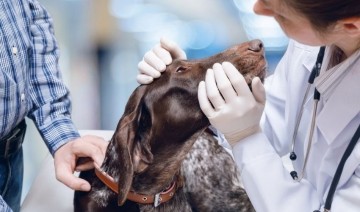
Dog Eye Discharge: When to Worry
Dogs might have discharge from their eyes for a variety of reasons, many of which are normal and healthy. But when should dog owners worry about discharge, and what might unusual discharge indicate about their pet’s health?
What Is Eye Discharge?
Eye discharge is tear drainage that serves several purposes to keep a dog’s eyes healthy. Tears keep the eye moist and comfortable, and nourish the cornea for clear vision. Tears also remove dust and debris from the eye’s surface, minimizing the risk of injury.
It is normal for some discharge to accumulate at the inner corner of a dog’s eye. This can appear as just a touch of moisture, a crusty residue, or even gunk, goop, or “eye boogers.” This accumulation is a combination of tears, body oil, dead skin cells, and dust. A small amount of discharge is normal, and is often more prominent in the morning or after the dog has been sleeping. So long as the amount of discharge is relatively constant from day to day without severe changes in color or texture, dog owners needn’t worry.
Some dog breeds are more prone to excessive eye discharge than others. Flat-faced breeds such as pugs and boxers, as well as dogs with more prominent eyes such as chihuahuas, often have compressed tear ducts and may develop drainage problems, increasing eye discharge. Dogs with loose facial skin, including bloodhounds and basset hounds, may accumulate eye discharge more readily as well. Finally, white-coated dogs, such as malteses and lhasa apsos, may show eye discharge more prominently because a pigment in canine tears turns red-brown when exposed to air, staining a dog’s fur and making the discharge seem more extreme. All of these examples are normal, however, and not a cause for concern.
When to Worry About Your Dog’s Eyes
While different dogs will naturally have different amounts of eye discharge, it is only when that discharge dramatically changes in quantity, color, or texture that dog owners need to be concerned. Different changes to watch for include…
- Much More Discharge Than Usual – This could indicate a clog in the tear duct or an injury to the eye that needs more flushing than tears can provide.
- Yellow or Green Discharge – Like other mucus discharge, this could be a sign of an eye infection, such as a wound or dry eye.
- White or Grayish Mucus – This is often a sign of conjunctivitis or dry eye, which can cause severe discomfort and could lead to blindness.
- Strong Foul Smell – A noxious odor from the discharge could indicate an infection that can cause vision changes or severe discomfort.
- Other Vision Changes – If the dog suddenly seems to squint more or has trouble seeing, even if the discharge has not changed dramatically, a veterinarian should be consulted.
- Other Eye Changes – If even small discharge changes are coupled with a swollen or bloodshot eye, excessive rubbing or pawing of the eye, or signs of pain, see a vet immediately.
Different types of health concerns could cause changes to a dog’s eye discharge. Allergies or irritants, such as a turned-in eyelash or eyelid abnormalities, could affect eye discharge. Tumors, corneal ulcers, head injuries, or even diseases such as distemper can all create eye problems.
Any sudden or severe change in a dog’s eye discharge should be followed up with a vet visit as soon as possible to diagnose the problem and arrange effective treatment. Depending on the cause of the discharge, treatments might include eyedrops, ointments, antibiotics, surgery, or other options to correct the problem and relieve the dog’s discomfort.
Keeping Your Dog’s Eyes Healthy
There are steps every dog owner can take to help keep their pet’s eyes healthy with a normal amount of discharge. Gently wiping the dog’s eyes with a clean, soft cloth as part of a regular grooming regimen will help reduce discharge accumulation and clear away any debris that might block drainage ducts. If the dog has long facial hair, trimming around the eyes – gently and carefully – with blunt-tipped scissors can minimize the risk of a loose hair irritating the eyes. When using any chemicals, including soaps, shampoos, or flea treatments, be sure to keep the products well away from the dog’s eyes. Providing a healthy diet rich in vision-supportive nutrients and antioxidants or adding supplemental treats such as blueberries, pumpkin, carrots, or sweet potatoes to your dog’s diet can also promote healthy eyes.
The most important thing a dog owner can do to protect their dog’s eyes is simply to be aware of the natural condition of the dog’s eye discharge, and to quickly note any changes to that discharge. Staying alert to a pet’s health can ensure prompt, effective treatment, before any eye issues degenerate into more serious concerns. By understanding dog eye discharge and when to worry, every dog owner can protect their pet’s eyes for a lifetime of clear vision.
